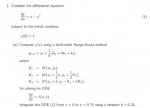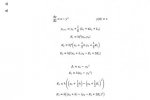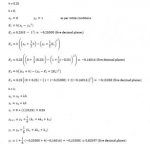ChrisHughes
New member
- Joined
- Mar 6, 2018
- Messages
- 1
Hi All,
Attached is 1) a) and b), with my solution for 1) a), which I would appreciate checking (I know the k should be a 0 for the initial conditions).
Stuck on b) though, with the following being what I know...
"Which one is the most accurate?"
Crank-Nicholson (modified Euler) is more accurate than Euler.
"Can you see this from the expression of LE for the ODE (1)?"
I know smaller mesh size leads to a more accurate result, and that local error in Euler is O(h2), with global error being O(h2) x (K/h) = O(h), where K/h being the width. Also know it is due to truncation.
Not convinced either of the above, even if correct, are sufficient explanation though. And I am struggling to evaluate LE for either. I know the mesh size is 0.25 from (a), and that I can differentiate f(x,y) twice.
Not sure how to get Xn and Xn+1, which I think I need to know to evaluate LE for each.
Euler is Yn+1 = Yn + HF(Xn, Yn).
Modified Euler is Yn+1 = Yn + 1/2(k1 + k2)
I would appreciate some help though, as I am quite stuck. No idea where that theta even comes from...
Attached is 1) a) and b), with my solution for 1) a), which I would appreciate checking (I know the k should be a 0 for the initial conditions).
Stuck on b) though, with the following being what I know...
"Which one is the most accurate?"
Crank-Nicholson (modified Euler) is more accurate than Euler.
"Can you see this from the expression of LE for the ODE (1)?"
I know smaller mesh size leads to a more accurate result, and that local error in Euler is O(h2), with global error being O(h2) x (K/h) = O(h), where K/h being the width. Also know it is due to truncation.
Not convinced either of the above, even if correct, are sufficient explanation though. And I am struggling to evaluate LE for either. I know the mesh size is 0.25 from (a), and that I can differentiate f(x,y) twice.
Not sure how to get Xn and Xn+1, which I think I need to know to evaluate LE for each.
Euler is Yn+1 = Yn + HF(Xn, Yn).
Modified Euler is Yn+1 = Yn + 1/2(k1 + k2)
I would appreciate some help though, as I am quite stuck. No idea where that theta even comes from...



